Brightness and Contrast Ratio
For the brightness, contrast, and color accuracy tests we depend on the hardware colorimeter and software to help calibrate the displays. As previously stated, we use a Monaco Optix XR (DTP-94) colorimeter and Monaco Optix XR Pro software. The software and hardware help users to get more accurate color from their displays. Before we get to the calibrated results, we took a quick look at the range of brightness and contrast without any color calibration.
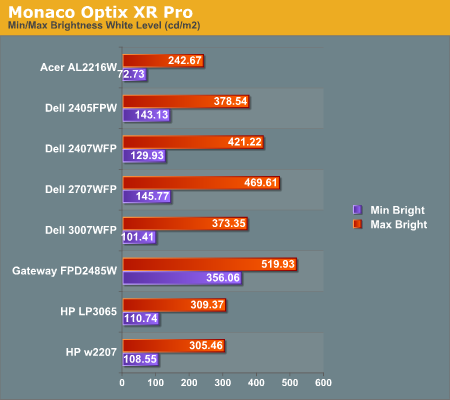
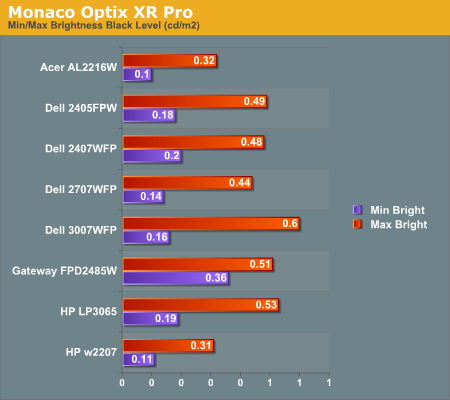
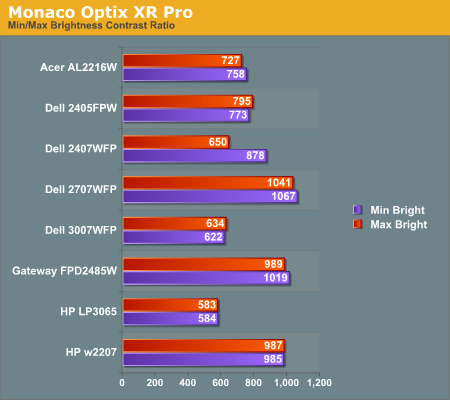
In the past we have seen LCDs that crank up the brightness level in order to increase the contrast ratio, but it's good to see that HP didn't go that route with the w2207. A maximum brightness level of 300 nits is pretty reasonable, and we don't see much reason to go beyond that. In practice, we tend to prefer a brightness level of around 200 nits, though others may prefer slightly brighter or darker. The HP w2207 can accommodate pretty much any desired brightness setting, and it does so while maintaining its exceptional ~1000:1 contrast ratio. That's one more item that sets it apart from the less-expensive Acer 22" LCD.
Color Accuracy
The problem with calibrating a display is that it doesn't help all applications. Specifically, the video overlay used when watching DVDs or other movies completely bypasses any color profiles, so you are stuck with the uncalibrated colors. Playing games and Windows Vista may also use the default color options - though in the case of the latter it's more a problem of determining how to set up your color profile properly. It is possible to tweak things somewhat on many LCDs using the OSD, but the amount of color correction that can be done via the OSD pales in comparison to color correction tables, and some LCDs (the Dell 3007WFP and HP LP3065 for example) are unable to adjust anything but brightness outside of software. Ideally, we would like to see video drivers begin to apply color profiles to all output - office applications, movies, games, or anything else.
For uncalibrated color accuracy, we adjusted the brightness as well as the contrast and colors (where applicable) using a "calibrate by eye" chart and the OSD controls. Also remember that color accuracy can vary from panel to panel even within the same model, and the results we are reporting are only from testing a single LCD. During testing, Monaco Optix XR Pro sends 24 color patches to the display with the colorimeter measuring the resulting values. The difference between what is requested and what the LCD actually shows is known as Delta E, with lower values being better. Any score less than one is basically "perfect" - the naked eye is not going to be able to tell the difference - and scores less than 2.0 are nearly perfect.
Ideally, you would want all of the tested colors to have a Delta E of less than 1.0, but almost no one is likely to have problems with anything scoring below 2.0. From 2.0 to 4.0, most people still won't notice the slight inaccuracies in the color palette, but when comparing displays side by side differences may be apparent - multimedia professionals in particular would prefer something better. Anything above 4.0 begins to represent a more significant deviance, and numerous scores above 6.0 will almost certainly be noticeable by just about anyone using the display. Consistency is also important, so a display that has very good scores overall but with high spikes on some colors may actually be less desirable than a display with a slightly higher but more consistent average Delta E. Note also that fluctuations of as much as one point in Delta E are possible during a short amount of time. It generally takes as much as 30 minutes for a display to warm up after it's first powered on, and all of our calibration and testing is performed after the displays have been running for at least one hour with the screensaver disabled.
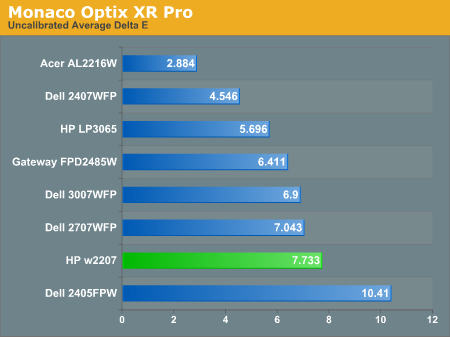
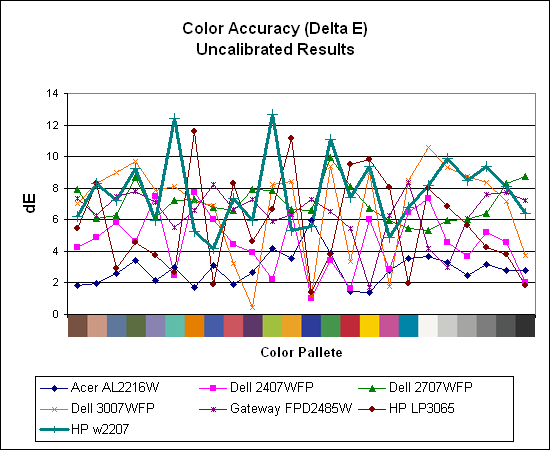
Without any form of color correction, the color accuracy of all of these displays is generally mediocre. The human eye will compensate quite a bit for differences between displays, so for most people even an average Delta E of 6.0 isn't going to be terrible. The HP w2207 rates a pretty poor 7.7 before calibration, besting only the two year old Dell 2405FPW. There are also quite a few spikes, with several colors having a Delta E of greater than 10.0. If you don't have color calibration equipment and you depend on accurate colors, the w2207 probably isn't the best choice. In fact, out of all of the LCDs we've tested so far, only the Acer AL2216W generates an uncalibrated Delta E result of less than 3.0. That particular display has other drawbacks, and we really wish that more of the displays could generate acceptable uncalibrated Delta E results.
For the brightness, contrast, and color accuracy tests we depend on the hardware colorimeter and software to help calibrate the displays. As previously stated, we use a Monaco Optix XR (DTP-94) colorimeter and Monaco Optix XR Pro software. The software and hardware help users to get more accurate color from their displays. Before we get to the calibrated results, we took a quick look at the range of brightness and contrast without any color calibration.



In the past we have seen LCDs that crank up the brightness level in order to increase the contrast ratio, but it's good to see that HP didn't go that route with the w2207. A maximum brightness level of 300 nits is pretty reasonable, and we don't see much reason to go beyond that. In practice, we tend to prefer a brightness level of around 200 nits, though others may prefer slightly brighter or darker. The HP w2207 can accommodate pretty much any desired brightness setting, and it does so while maintaining its exceptional ~1000:1 contrast ratio. That's one more item that sets it apart from the less-expensive Acer 22" LCD.
Color Accuracy
The problem with calibrating a display is that it doesn't help all applications. Specifically, the video overlay used when watching DVDs or other movies completely bypasses any color profiles, so you are stuck with the uncalibrated colors. Playing games and Windows Vista may also use the default color options - though in the case of the latter it's more a problem of determining how to set up your color profile properly. It is possible to tweak things somewhat on many LCDs using the OSD, but the amount of color correction that can be done via the OSD pales in comparison to color correction tables, and some LCDs (the Dell 3007WFP and HP LP3065 for example) are unable to adjust anything but brightness outside of software. Ideally, we would like to see video drivers begin to apply color profiles to all output - office applications, movies, games, or anything else.
For uncalibrated color accuracy, we adjusted the brightness as well as the contrast and colors (where applicable) using a "calibrate by eye" chart and the OSD controls. Also remember that color accuracy can vary from panel to panel even within the same model, and the results we are reporting are only from testing a single LCD. During testing, Monaco Optix XR Pro sends 24 color patches to the display with the colorimeter measuring the resulting values. The difference between what is requested and what the LCD actually shows is known as Delta E, with lower values being better. Any score less than one is basically "perfect" - the naked eye is not going to be able to tell the difference - and scores less than 2.0 are nearly perfect.
Ideally, you would want all of the tested colors to have a Delta E of less than 1.0, but almost no one is likely to have problems with anything scoring below 2.0. From 2.0 to 4.0, most people still won't notice the slight inaccuracies in the color palette, but when comparing displays side by side differences may be apparent - multimedia professionals in particular would prefer something better. Anything above 4.0 begins to represent a more significant deviance, and numerous scores above 6.0 will almost certainly be noticeable by just about anyone using the display. Consistency is also important, so a display that has very good scores overall but with high spikes on some colors may actually be less desirable than a display with a slightly higher but more consistent average Delta E. Note also that fluctuations of as much as one point in Delta E are possible during a short amount of time. It generally takes as much as 30 minutes for a display to warm up after it's first powered on, and all of our calibration and testing is performed after the displays have been running for at least one hour with the screensaver disabled.


Without any form of color correction, the color accuracy of all of these displays is generally mediocre. The human eye will compensate quite a bit for differences between displays, so for most people even an average Delta E of 6.0 isn't going to be terrible. The HP w2207 rates a pretty poor 7.7 before calibration, besting only the two year old Dell 2405FPW. There are also quite a few spikes, with several colors having a Delta E of greater than 10.0. If you don't have color calibration equipment and you depend on accurate colors, the w2207 probably isn't the best choice. In fact, out of all of the LCDs we've tested so far, only the Acer AL2216W generates an uncalibrated Delta E result of less than 3.0. That particular display has other drawbacks, and we really wish that more of the displays could generate acceptable uncalibrated Delta E results.










43 Comments
View All Comments
Dantzig - Thursday, August 2, 2007 - link
I recently picked one of these up for $360 - 10% off coupon + tax at Circuit City. The final price was about $340 which I feel is very competitive when compared to the Samsung 226BW/CW. I could have purchased a 226BW for slightly less and had to wait for it to be shipped and played the panel lottery or spent more for the 226CW which doesn't have a high gloss screen and has an annoying silver bar on the bottom of the display frame.It's just simply a beautiful monitor. I switched my home monitor from a Dell 2005FPW with an S-IPS panel to the HP and took the Dell to work. While I know that the HP uses a 6-bit panel, the colors look better to me than those of the 2005FPW. The different in response time is definitely noticeable while gaming and moving mouse pointers quickly around the screen.
If you're in the market for a 22" widescreen display with a TN panel, this is the one to get.
zemane - Wednesday, August 1, 2007 - link
Isn't 4:3 the standard aspect ratio?
JarredWalton - Thursday, August 2, 2007 - link
Yes, for everything but your typical 1280x1024 (5:4) 19" LCDs. There are some 4:3 19" displays (1400x1050 resolution), but most are 5:4.Bonesdad - Wednesday, August 1, 2007 - link
Consider the Acer AL2051W if you want to do a MVA panel review. I just bought one for $190 on Newegg and am very pleased so far. Fantastic viewing angle, stated at 176 degrees and from the looks of it, its not far off. A bit of backlight bleeding, but not out of the ordinary. This is an excellent panel for the price.Pirks - Wednesday, August 1, 2007 - link
there are two nice 28" monitors at newegg, see models aboveboth are about $650 which is dirt cheap for 28"
could you guys do a review of one of those, or even both?
I'm sure EVERYBODY would be interested!
these two seem like a huge hit, they just BLOW dell's 27" panels
JarredWalton - Wednesday, August 1, 2007 - link
I asked for one from ViewSonic at one point. I don't recall why we didn't get one - we've been working on getting a ViewSonic contact. As far as quality, a few people are saying that they use a TN panel, so they certainly wouldn't be as good as stuff like the 27" Dell (which uses PVA). That would probably account for the lower price as well -- at least somewhat.CSMR - Wednesday, August 1, 2007 - link
Great to have the detailed light/dark/contrast measurements at different brightness settings. Good work.augiem - Wednesday, August 1, 2007 - link
Thank you so much for including viewing angle pictures! I can't tell you how important this aspect of a monitor is to me. Doing graphics work, TN panels are simply unusable because of the vertical viewing angle issues. This is the first site I've seen do photographic comparisons and it's AWESOME! :)zero2dash - Wednesday, August 1, 2007 - link
We bought this w2207 a few weeks ago to replace 2 aging 21" Trinitron CRTs...one that has a "too bright" problem (despite brightness being 0) and another in which the red gun is going out (causing the monitor to have 'red seizures').This monitor is great.
Originally I was going to get a 226BW but I didn't want to bother with getting one panel over another (ie trying to find an S panel but getting a C instead). The glossy coating on the w2207 makes it even better, even though (as mentioned) it's a PITA to keep it clean and clean it when it's dirty/dusty. Seems like it takes 5 minutes to completely clean the screen with a damp cloth and have it come out clean but without any dust at the same time.
That being said...I highly recommend this monitor. When we bought ours, it was on sale for $339 at Sears; a week later, it was down to $249 (and I called and got the $90 credit). Wish I would've had the money then to buy a 2nd for that price. =)
JarredWalton - Wednesday, August 1, 2007 - link
If you could find this on sale for $250, it would definitely be a no-brainer. At current prices, you'll have to think about it a bit more. It may very well be the best 22" monitor on the market, but I would take a 24" Gateway over it (even with the higher cost).